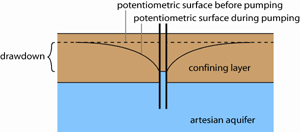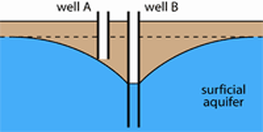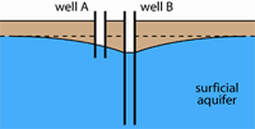¹wa·ter \’wÓ-tər, ‘wá-\
1 a: the liquid that descends from the clouds as rain, forms streams, lakes, and seas, and is a major constituent of all living matter and that when pure is an odorless, tasteless, very slightly compressible liquid oxide of hydrogen H2O which appears bluish in thick layers, freezes at 0° C and boils at 100° C, has a maximum density at 4° C and a high specific heat, is feebly ionized to hydrogen and hydroxyl ions, and is a poor conductor of electricity and a good solvent
What is Groundwater? Groundwater is water below the land surface that fills the spaces between grains of sand, gravel and rocks or fills cracks and fractures in the bedrock or sandstone. Saturated zones in sediment such as sand and gravel, and in fractured rock and sandstone formations, that receive, store, and transmit water to wells are called aquifers.
Clean and plentiful groundwater is a vital resource for personal and economic health everywhere in the United States.
Each day, over 130 million Americans get their drinking water from groundwater. About 40 million are supplied from individual home wells.
Groundwater is a safe, economic and an environmentally friendly resource. We don’t need to dam up rivers and disturb ecology to store water. Mother Nature has made the geology of the earth a natural storage place for groundwater. We must all play a role in protecting America’s groundwater.
To that end, private well owners have a special responsibility to ensure the safety of their drinking water.
How do we get Groundwater? A water well is needed to reach the aquifer where groundwater is found. Today, most wells are made by drilling into the aquifers using specially designed drilling machines (rigs) to access the groundwater beneath the surface. In most cases electric pumps are used to raise the water to the surface.
The creation of a water well consists of several elements. After selecting the site to drill the well, the process usually include drilling, development, testing and equipment installation. (Source: American Groundwater Trust)
Types of Wells
In many areas wells are the only way to access groundwater. There are three most common wells based on how they are made: dug wells, driven wells, and drilled wells (Waller, 1999).
Driven wells are built by driving a small diameter pipe into soft ground, like driving a nail into wood. Driven wells are only efficient at reaching shallow water.
Drilling is the most common way to create a well today. Drilled wells typically are constructed from 25-400+ feet in depth.

Water Levels in Wells
Water levels in wells vary according to seasonal variations in rainfall, recharge rate, and pumpage. The surface that represents the level to which water will rise in a tightly cased (sealed) well is the potentiometric surface. This surface is the result of all the pressures on groundwater. The water table is a particular potentiometric surface for unconfined aquifers. The water surface in a well into an artesian aquifer rises above the level of the aquifer, because the water is being pushed toward the potentiometric surface (Fetter, 1994).
When water is pumped from a well faster than water can refill the pore spaces around the well, the potentiometric surface is lowered in the area of the well. The vertical change in the level of the potentiometric surface at the well is called the drawdown. Drawdown is most dependent on the rate of pumping. The 3-dimensional deflection of the potentiometric surface around the well is the cone of depression, and is controlled by the speed of recharge to the pore spaces near the well.
A cone of depression in one well can impact the water level in a nearby well. Below, well B is pumping out groundwater, thereby lowering the water level in well A, which is not pumping. If pumping at well B increases, the cone of depression can lower the water level sufficiently to leave well A dry.
Source: University of Texas, Austin


